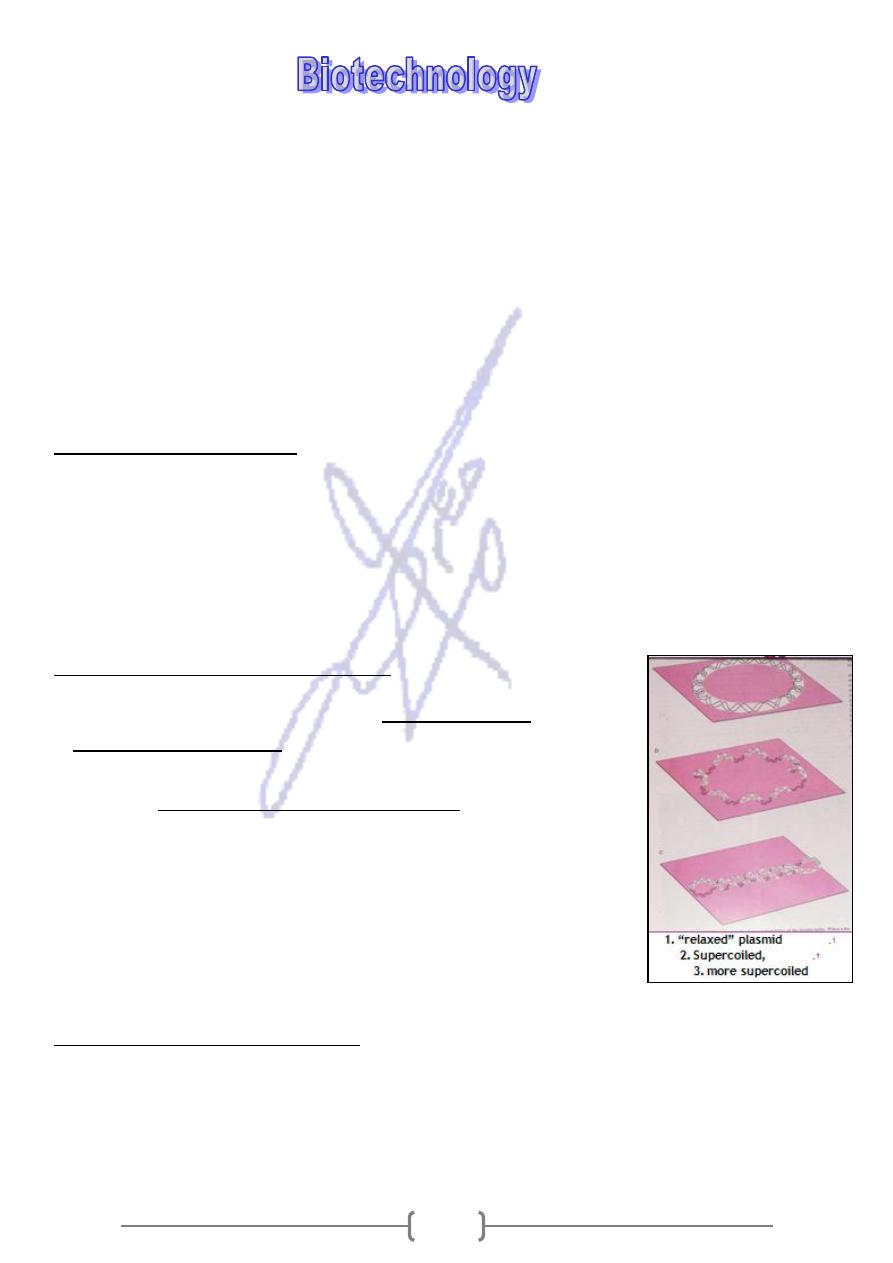
137
Genetic engineering: is the use of technology to alter the genomes of viruses,
bacteria, and other cells for medical or industrial purposes.
Biotechnology includes genetic engineering and other techniques that make use of
natural biological systems to produce a product or to achieve an end desired by
human beings.
Genetic engineering has the capability of altering the genotypes of unicellular
organisms as well as the genotypes of multicellular plants and animals, including
ourselves.
f a gene
The cloning o
The cloning of a gene produces many identical copies.
Recombinant DNA technology (rDNA) is used when a very large quantity of the gene is
required.
The use of the polymerase chain reaction (PCR) creates fewer copies within a laboratory
test tube.
DNA Technology
Recombinant
DNA from two or
contains
Recombinant DNA (rDNA)
more different sources.
To make rDNA, it often begins by selecting a vector, the means
rDNA is introduced into a host cell.
by which
One common type of vector is a plasmid.
Plasmids are small accessory rings of DNA from bacteria. The
ring is not part of the bacterial chromosome and replicates on its
own.
Plasmids were discovered by investigators studying the
reproduction of the intestinal bacterium Escherichia coli (E. coli).
Recombinant DNA (rDNA)
Two enzymes are needed to introduce foreign DNA into vector DNA.
1. Restriction enzyme, cleaves the vector’s DNA
2. DNA ligase, seals foreign DNA into the opening created by the restriction enzyme.
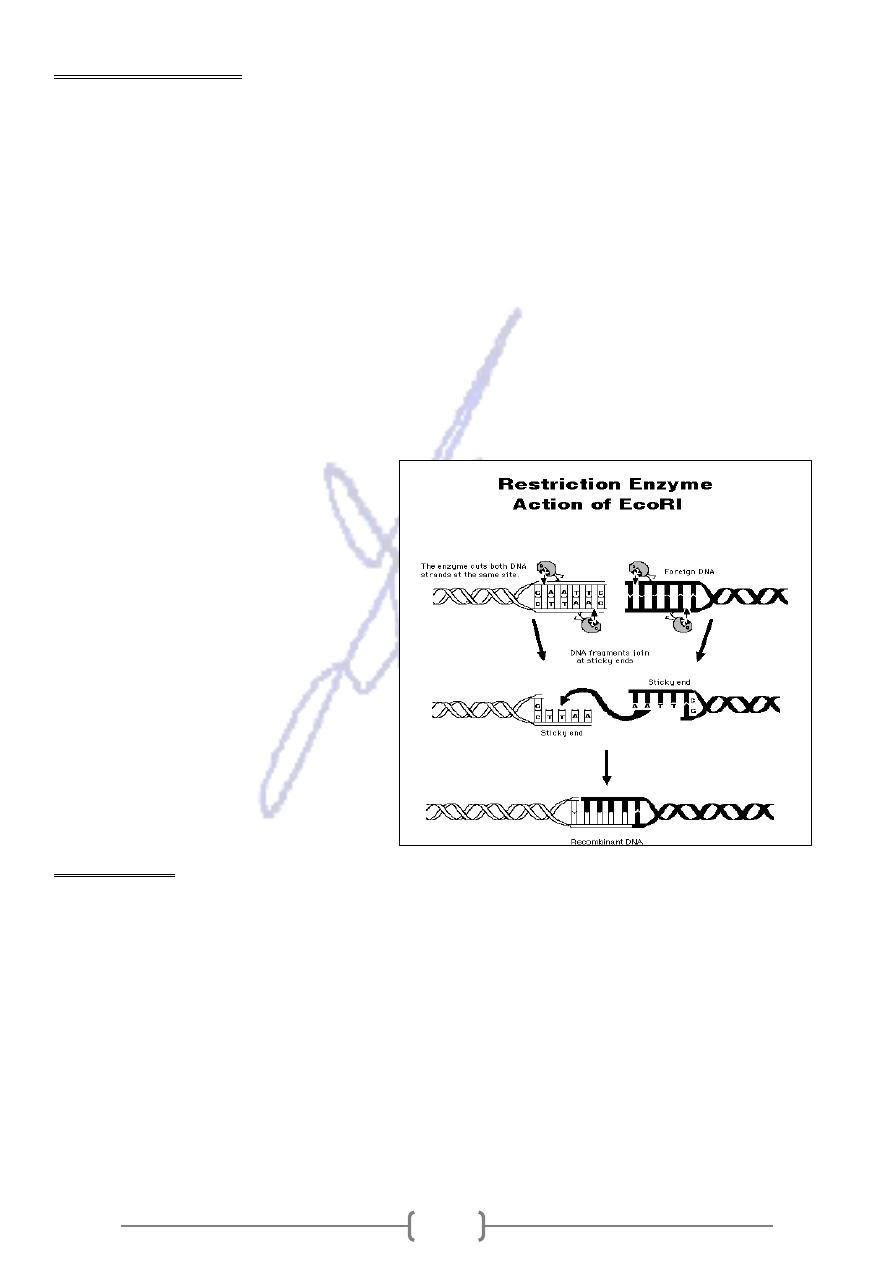
138
1. Restriction enzyme
Hundreds of restriction enzymes occur naturally in bacteria.
They are called restriction enzymes because they restrict the growth of viruses, but
they also act as molecular scissors because each one cuts DNA at a specific cleavage site.
For example, the restriction enzyme called EcoRI always cuts double-stranded
DNA in this manner when it has this sequence of bases:
GAATTC so this enzyme cleaves the sequence between the G and the A, this
produces DNA restriction fragments.
Notice there is now a gap into which a piece of foreign DNA can be placed if it ends in
bases complementary to those exposed by the restriction enzyme.
The single-stranded, with complementary ends of the two DNA molecules are called
“sticky ends” because they can bind a piece of foreign DNA by complementary base
pairing.
Sticky ends facilitate the insertion of
foreign DNA into vector DNA.
:
2. DNA ligase
the second enzyme needed for preparation of rDNA molecule, used to seal the
foreign piece of DNA into the vector.
DNA splicing is now complete; an rDNA molecule has been prepared.
Bacterial cells take up recombinant plasmids, especially if they are treated to make
them more permeable.
Thereafter, if the inserted foreign gene is replicated and actively expressed, so it is
possible to recover either the cloned gene or a protein product.
In order for gene expression to occur in a bacterium, the gene has to be accompanied
by regulatory regions unique to bacteria. Also, the gene should not contain introns
because bacteria don’t have introns.
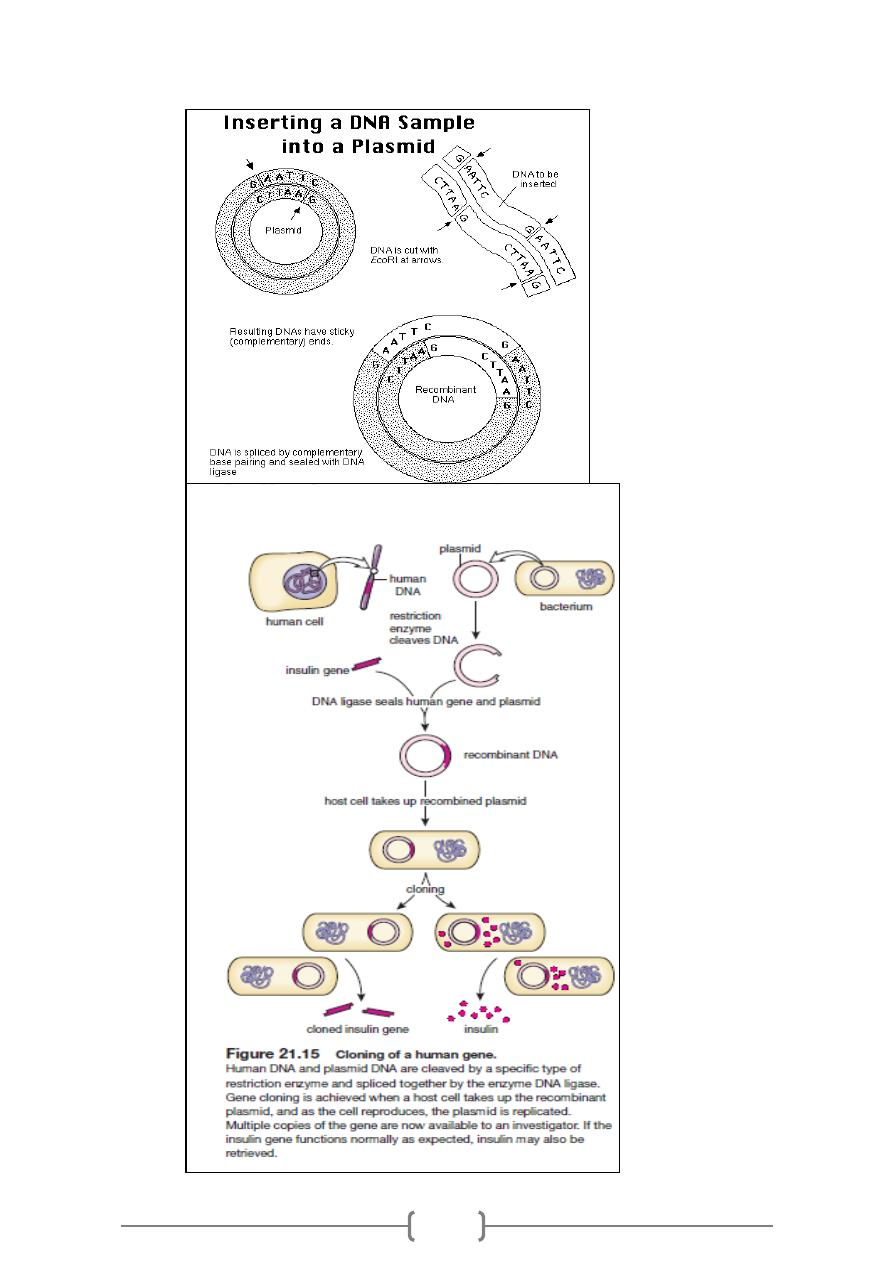
139
Example: Cloning of human Insulin gene in a bacterium
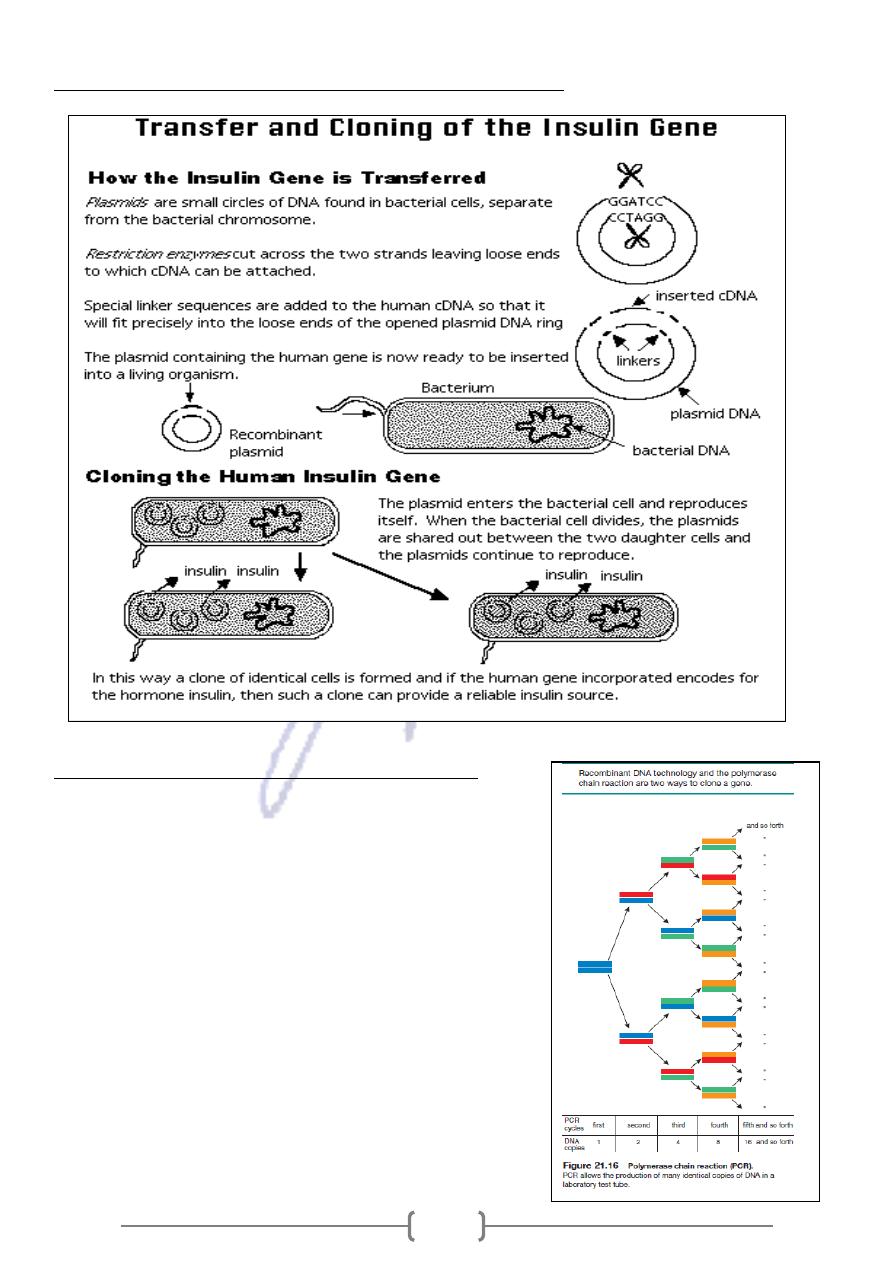
141
Cloning of human insulin gene in a bacterium
The polymerase chain reaction (PCR)
PCR can create millions of copies of a single
gene, or any specific piece of DNA, in a test tube.
PCR is very specific—the targeted DNA sequence can
be less than one part in a million of the total DNA
sample!
This means that a single gene among all the human
genes can be amplified (copied) using PCR.
PCR requires the use of DNA polymerase enzyme
that carries out DNA replication, and a supply of
nucleotides for the new DNA strands, and a primer.
PCR is a chain reaction because the targeted DNA is
repeatedly replicated as long as the process
continues.
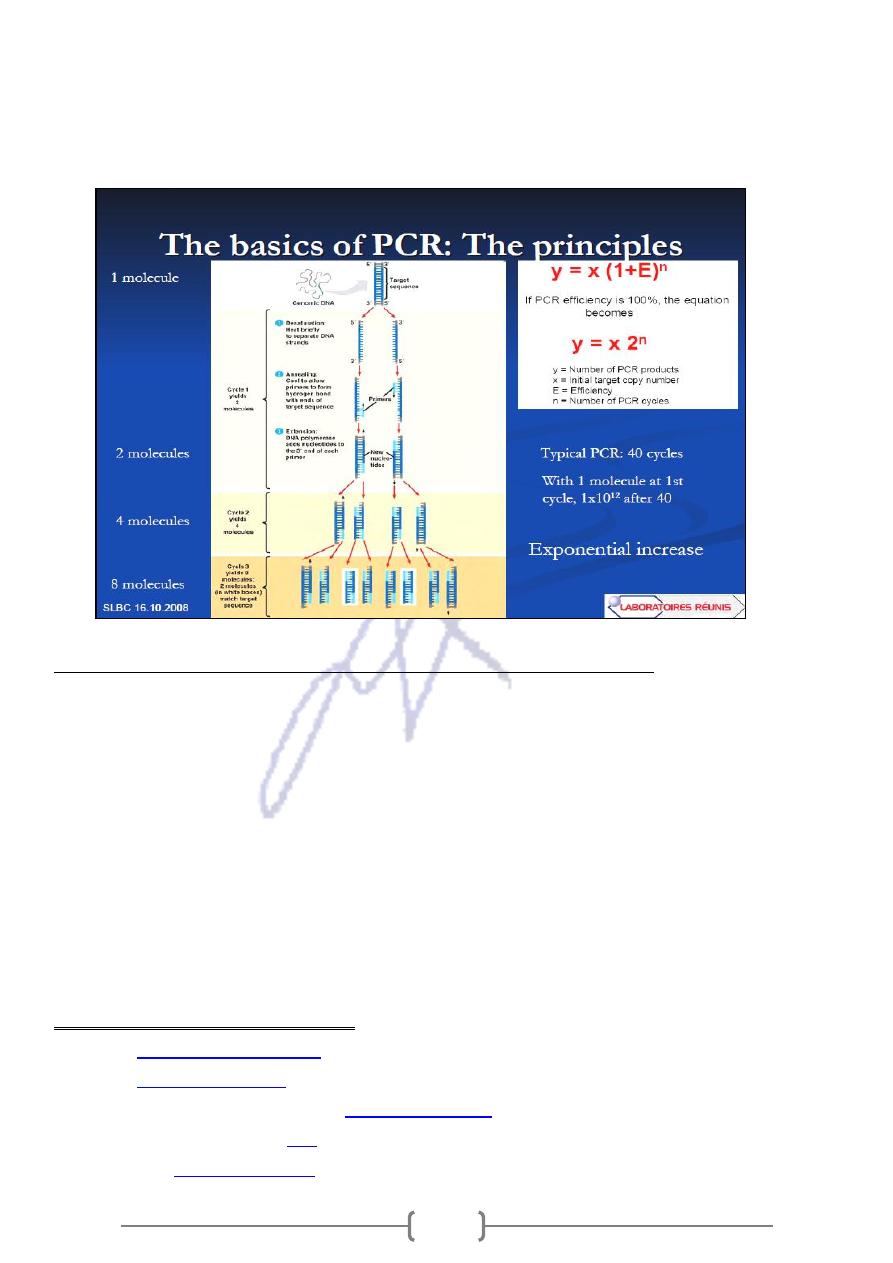
141
The temperature-insensitive (thermostable) DNA polymerase was extracted from
the bacterium Thermus aquaticus, which lives in hot springs. The enzyme can
withstand the high temperature used to separate double-stranded DNA;
therefore, replication need not be interrupted by the need to add more enzyme.
Restriction Fragments Length Polymorphism(RFLPs)
Is a technique that exploited the variation in homologous DNA sequence.
It refers to a differences between samples of homologous DNA molecule that comes
from different locations of restriction enzymes site. When the DNA of a person is
treated with restriction enzymes, the result is a unique collection of different-sized
fragments.
In RFLP analysis, the DNA sample is broken into pieces (digested) by restriction
enzymes and the resulting fragments are separated according to their lengths (size)
by gel electrophoresis, and the result is a pattern of distinctive bands.
If two DNA patterns match, there is a high probability that the DNA came from the
same person.
RFLP and PCR: Clinical Application:
,
genetic fingerprinting
1.
,
genome mapping
2.
,
genetic disorders
localization of genes for
3.
for disease,
risk
determination of
4.
.
paternity testing
and
5.
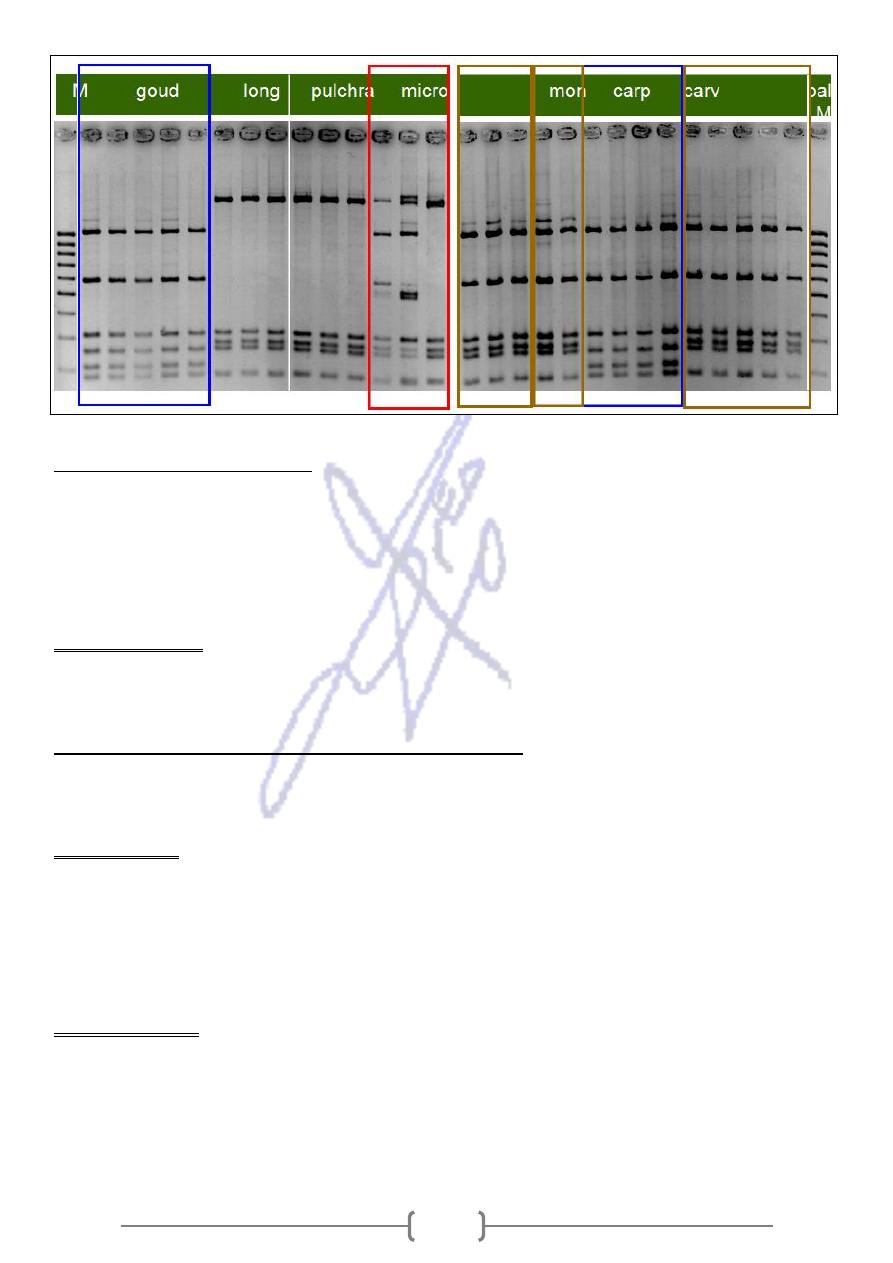
142
Biotechnology products
Today, bacteria, plants, and animals are genetically engineered to produce biotechnology
products.
Organisms that have had a foreign gene inserted into them are called transgenic
organisms.
1. From Bacteria;
When the foreign gene is inserted into bacterium, replicated and actively expressed, a
large amount of protein product can be obtained.
Biotechnology products produced by bacteria includes:
insulin, human growth hormone, t-PA (tissue plasminogen activator), and hepatitis
B vaccine, are now on the market.
2. From Plants
Techniques have been developed to introduce foreign genes into plants to produce human
proteins, such as hormones, clotting factors, and antibodies, in their seeds.
One type of antibody made by corn can deliver radioisotopes to tumor cells, and another
made by soybeans can be used to treat genital herpes virus.
3. From animals:
Gene pharming, the use of transgenic farm animals to produce pharmaceuticals.
Genes that code for therapeutic and diagnostic proteins are incorporated into the
animal’s DNA, and the proteins appear in the animal’s milk.
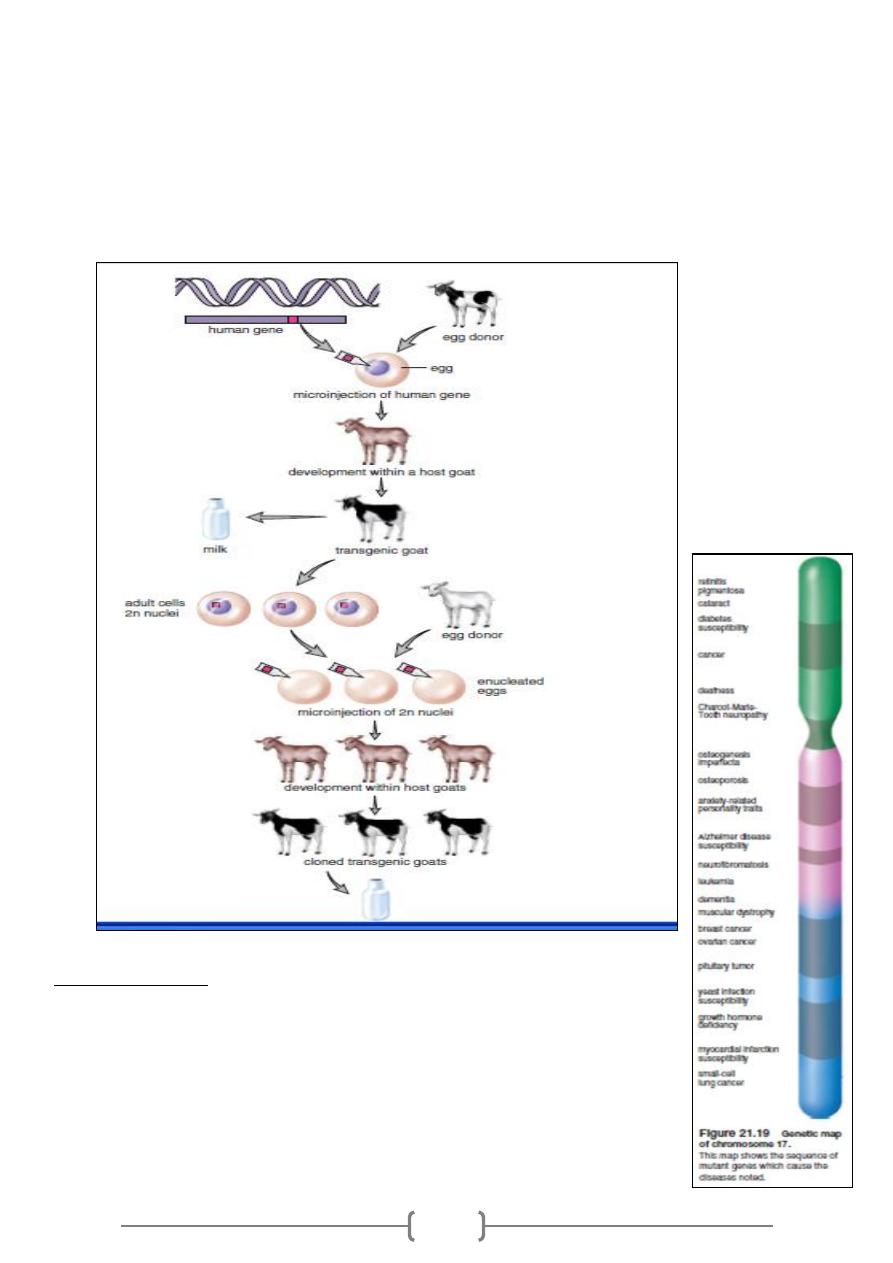
143
There are plans to produce drugs for the treatment of cystic fibrosis, cancer, blood
diseases, and other disorders.
for producing transgenic mammals: DNA containing the gene of interest is injected
into donor eggs. Following in vitro fertilization, the zygotes are placed in host
females where they develop. After female offspring mature, the product is secreted in
their milk.
Gene Therapy
Is the replacement of a missing gene product by inserting a normal
gene into human cells for the treatment of a disorder.
This approach is best suited to the correction of loss-of-function
mutations that result in a nonfunctional or missing gene product; the
insertion of a normal gene supplies the missing product.
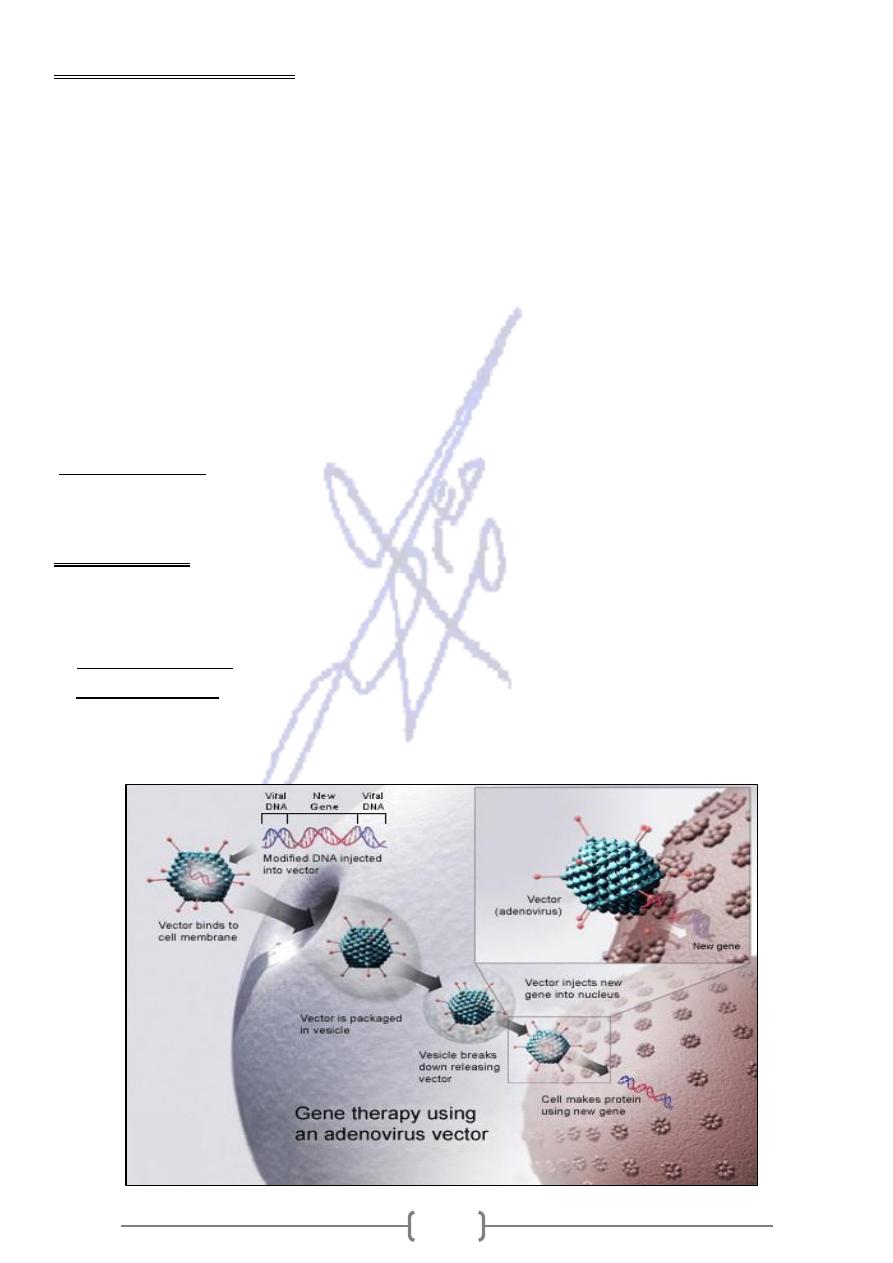
144
Gene Replacement Therapy
Gene replacement therapy is the use of genes to treat various recessive disorders and
other human illnesses such as:
SCID (severe combined immunodeficiency) the children lack the enzyme ADA
(adenosine deaminase) that is involved in the maturation of T and B cells.
Familial hypercholesterolemia,
Cystic fibrosis patients lack a gene that codes for the transmembrane carrier of the
chloride ion. Patients often die due to numerous infections of the respiratory tract
Hemophilia
Cancer.
Gene therapy includes both ex vivo (outside the body) and in vivo (inside the body)
methods.
DNA Vectors
There are many techniques for introducing genes into cells, including:
1. Viral vectors:
Offer highly efficient transfer of therapeutic genes into somatic cells, because viruses
have evolved cleaver methods for inserting their genes into cells. These includes:
, a double stranded DNA virus
Adenovirus vector
A.
, it is a form of RNA virus, are able to insert copies of their genomes
Retroviral vector
B.
into the nuclei of host cells after reverse transcribting their viral RNA into double-
stranded DNA.
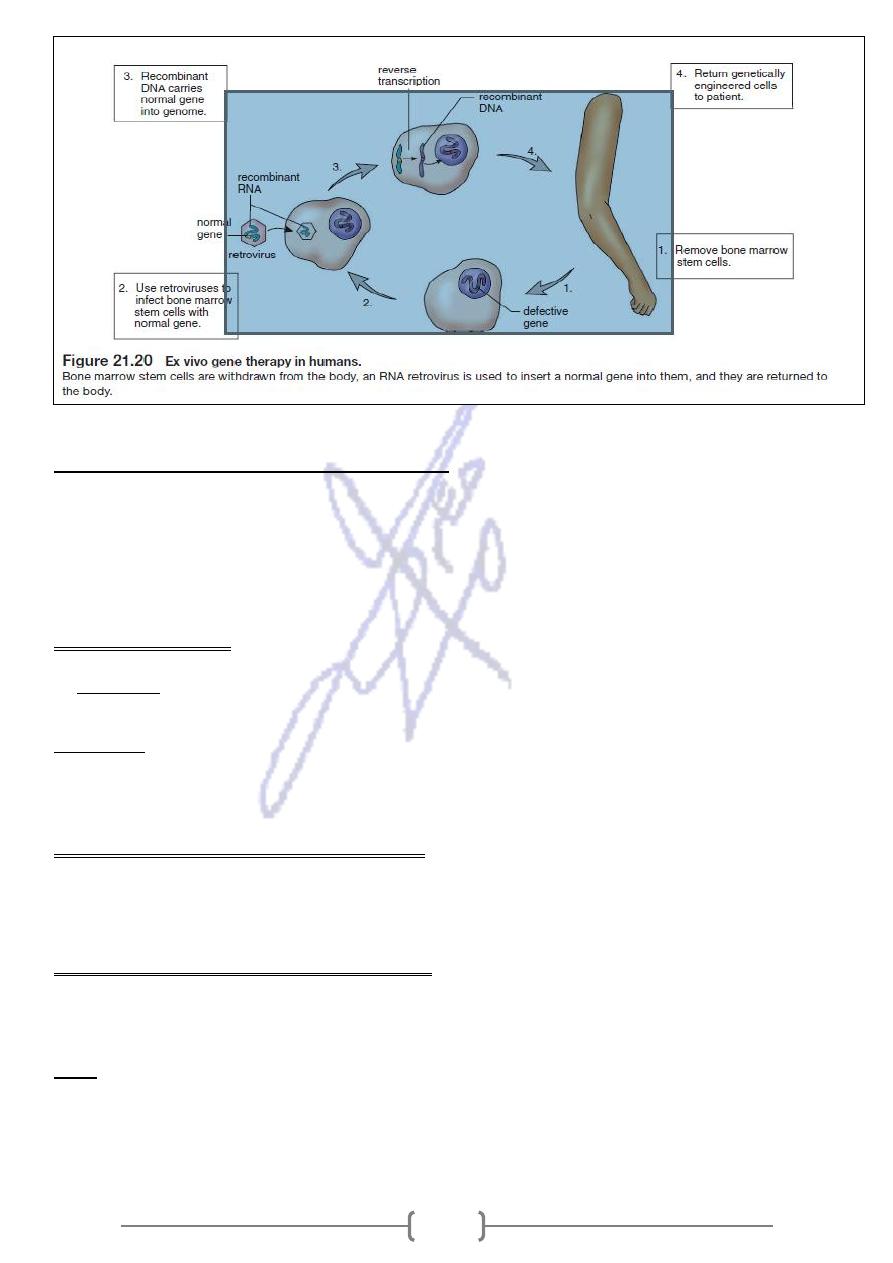
145
including:
drawbacks
Viral vector have several
Low or transient expression of the gene product
Limited insert size
Generation of immune responses
The potential for oncogenesis.
includes:
2. Non viral Vectors:
a fat body that can accept large DNA inserts, it fuse with cells allowing the
:
Liposome
A.
DNA insert to enter the cell.
Drawback:
Most of liposomes are degraded in the cytoplasm and those that are not degraded are
unable to enter the nucleus.
direct introduction of “naked” DNA
3. The
(a human DNA segments cloned into a plasmid). The DNA enter the cell escape from
degradation, and temporarily encode proteins.
because they contain functional centromers
,
4. Synthetic human artificial chromosomes
and telomeres, they should be able to integrate and replicate in human nuclei, but they lack
the transfer efficiency of viral vectors.
or
function
-
of
-
gain
: Gene replacement therapy are not effective in correcting
Note
dominant mutations, so gene blocking methods are being developed.
